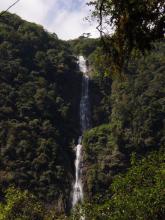Explore Bhutan Cultural Library

This collection contains essays on various genres of oral traditions in Bhutan, as well as other cultural subjects. Each text is linked to relevant places and subjects, such that users can explore the rich tapestry of Bhutanese culture through different media.
Texts in this collection
The list below includes texts from this Collection’s Subcollections.
The papermaking process in Bhutan, including raw materials, its creation, its origins in the country, and the historic role of the paper tax in relations between Bhutan and Tibet.
A summary of the four parts that constitute the Peling Ging Sum, a set of ritual dances to identify, destroy, and dispatch negative forces attributed to Pema Lingpa (1450-1521).
An overview of the contents and versions of the Pema Kathang or Pema Thangyig, biographies of Guru Rinpoche, and the master's significance in Bhutan.
The phola ritual to appease local guardian deities as conducted in Ura, Bumthang.
Phowa literally means transference. In phowa practice, the consciousness of a person is transferred to enlightenment or a higher state of being. It is often practiced or applied by spiritual people at the time of death.
This piece was initially published in Bhutan’s national newspaper Kuensel in a series called "Why we do what we do".
A translation of the Praise to the Noble Qualities of the Excellent Pristine Wisdom (དཔལ་ཡེ་ཤེས་ཡོན་ཏན་བཟང་པོའི་བསྟོད་པ།) dedicated to Mañjuśrī as recited in Bhutan.
Today, in Bhutan there are many kinds of scriptures written on cloth and put up on a pole vertically. In Tibet, where there are fewer trees, they would print the prayers on cloth or paper in square forms and hang them on ropes horizontally.
This piece was initially published in Bhutan’s national newspaper Kuensel in a series called "Why we do what we do".
A summary of the traditional importance of buckwheat noodles, or puta, as a staple of the Bumthang diet.
An overview of the Raksa Mangcham, a ritual dance depicting the effects of karma and its consequences, manifested through the actions of the Lord of Death, who judges the recently deceased.
Rabney is a consecration ritual. It comes from the Sanskrit term pratiṣṭhita – in which prati means good or well and sthita to remain or sustain. Thus, it is basically a process of inviting the enlightened spirits of the Buddhas to abide or remain well in the sacred objects.
This piece was initially published in Bhutan’s national newspaper Kuensel in a series called "Why we do what we do".
The metaphor of turning the wheel is used to describe the act of teaching because when the enlightened masters teach, the inner wheel of understanding and realization is turned in the minds of the disciples.
This piece was initially published in Bhutan’s national newspaper Kuensel in a series called "Why we do what we do".
Rimdro literally means service. Rimdro comprises rituals, ceremonies and practices, which are undertaken for a wide range of purposes including elongating life, overcoming illness, accumulating wealth, having good harvest, successfully finishing projects and overcoming hindrances. Some rimdos are calendar events and undertaken seasonally or annually while others are observed as and when necessary.
This piece was initially published in Bhutan’s national newspaper Kuensel in a series called "Why we do what we do".
An overview to the 'Seven Precious Possessions' of a chakravartin, or 'wheel-turning king'.
A summary of the compilation and contents of the Rinchen Terzö (rin chen gter mdzod), the cumulative treasure teachings.
An introduction to the functions of the song "Samyekyi Salang" and a brief exposition on some of its lyrics.
An account of the origins, constituent activities, and social functions of sang, an annual ceremony conducted by women in Ura village, Bumthang.
A summation of the rationale for the development of an altruistic mind.
The word serkem is an honorific term for offering libation. Kem is an old term for alcohol or container of alcohol. So offering of alcohol from a wooden jug or from a container is called offering kem. When the kem is poured into a bowl or a cup, made of or plated with gold (ser), then the offering becomes serkem.
This piece was initially published in Bhutan’s national newspaper Kuensel in a series called "Why we do what we do".
A basic description of the consecration process for serto, the topmost architectural element of religious buildings in Bhutan.
Most Bhutanese Buddhist rituals contain the set of seven practices known as yoen lak duen pa (ཡན་ལག་བདུན་པ་). The seven practices prostration (ཕྱག་), offering (མཆོད་པ་), confession (བཤགས་པ་), rejoicing (རྗེས་སུ་ཡི་རང་བ་), request to live long (བཞུགས་པར་གསོལ་བ་འདེབས་པ་), request to turn the wheel of Dharma (ཆོས་ཀྱི་འཁོར་ལོ་སྐོར་བར་བསྐུལ་བ་) and to dedicate the merits (བསྔོ་བ་).
This piece was initially published in Bhutan’s national newspaper Kuensel in a series called "Why we do what we do".
An overview of the act of shakpa, or confession.
A summary of the plot of the Shawa Shachi dance and the meanings behind its major characters.
An introdcution to the origins of and curricula for Himalayan Buddhist institutes of higher education known as shedra.
The role of the Heart Sutra in Bhutanese Buddhist practice and worldview, as presented for a local audience.